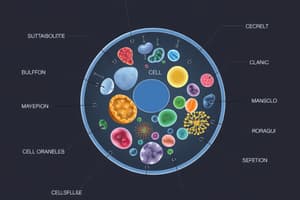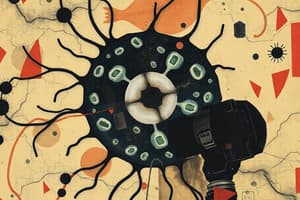Podcast
Questions and Answers
What are the two major parts of a typical cell visible under a light microscope?
What are the two major parts of a typical cell visible under a light microscope?
- Cytoplasm and protoplasm
- Nucleus and cytoplasm (correct)
- Cell membrane and cytoplasm
- Nucleus and plasma membrane
Cell theory states that cells can arise from spontaneous generation.
Cell theory states that cells can arise from spontaneous generation.
False (B)
Who is credited with discovering cells in the 6th century?
Who is credited with discovering cells in the 6th century?
Robert Hooke
The most abundant component of living cells is _______.
The most abundant component of living cells is _______.
Match the following components to their respective percentages in a typical cell:
Match the following components to their respective percentages in a typical cell:
Which of the following substances primarily composes the protoplasm of a cell?
Which of the following substances primarily composes the protoplasm of a cell?
Electrolytes are important for maintaining osmotic pressure and acid-base equilibrium within cells.
Electrolytes are important for maintaining osmotic pressure and acid-base equilibrium within cells.
Name the two types of nucleic acids found in cells.
Name the two types of nucleic acids found in cells.
Flashcards
What is a cell?
What is a cell?
The fundamental building block of life, responsible for all its functions.
Cell Theory
Cell Theory
They are composed of one or more cells, cells are the basic unit of structure and function, and cells arise from pre-existing cells.
What is protoplasm?
What is protoplasm?
The living substance within a cell, composed of cytoplasm and nucleoplasm.
Why is water important for cells?
Why is water important for cells?
Signup and view all the flashcards
What are electrolytes?
What are electrolytes?
Signup and view all the flashcards
What are proteins?
What are proteins?
Signup and view all the flashcards
What is the role of lipids?
What is the role of lipids?
Signup and view all the flashcards
What are carbohydrates?
What are carbohydrates?
Signup and view all the flashcards
Study Notes
Cell Structure and Function
- Cells are the basic structural and functional units of all living organisms, from single-celled organisms to multicellular organisms.
- Robert Hooke, in the 17th century, discovered cells using a light microscope.
- A typical cell consists of a nucleus and cytoplasm.
Cell Theory
- All living things are composed of one or more cells.
- Cells are the basic units of structure and function in living organisms.
- Cells come only from pre-existing cells through cell division.
Cell Composition
- Cells are primarily composed of protoplasm, a living substance enclosed by a plasma membrane.
- Protoplasm is mainly composed of water, electrolytes, proteins, lipids, carbohydrates, and nucleic acids.
- Water makes up a large percentage of the cell's total chemical composition (70-85%).
- Other key components include electrolytes (2-3%), proteins (10-20%), lipids (15%), carbohydrates (1%), and nucleic acids (2%).
Protoplasm Properties
- Conductivity: Cells transmit electrical signals.
- Contraction: Muscle cells can change size or shape.
- Respiration: Cells use oxygen and nutrients to produce energy.
- Absorption: Cells take in materials from their surroundings.
- Secretion: Cells release various substances, including hormones and enzymes.
Studying That Suits You
Use AI to generate personalized quizzes and flashcards to suit your learning preferences.




